Lunar New Year: 10 Australian tigers
Think you know tigers? What about those found in Australia? This Lunar New Year take a look at these museum critters that share the tiger moniker.
2022 is the Lunar New Year of the tiger, but how many Australian tigers can you name?
There are probably more than you think—animals that have been given the name for their similarity in behaviour or appearance to the world’s biggest cats.
Let’s explore some examples from the museum’s collection.
Tiger Snake
Fortunately we don’t have to worry too much about big cats roaming free in Australia, but we do have a different tiger to keep an eye out for.
The Tiger Snake is one of the world’s most venomous snakes, found only in Australia.
These serpents get their name from the yellow-edged crossbanding along their bodies, but their colouration can vary quite a lot and some may not have these stripes at all.
The museum has several hundred tiger snakes in the collection, which allows scientists to study any changes to the animals over time.
We also have some early examples of Tiger Snake anti-venom in the collection, first made by biotechnology company CSL in the 1930s—something that has saved a lot of lives since.
Tiger Quoll
Confusingly, the Tiger Quoll doesn’t have stripes at all; it is also known as the Spotted-tailed Quoll because, well, it has spots on its tail.
No matter the confusion (common names are often a sore point with scientists), this animal is the largest carnivorous marsupial on mainland Australia.
It is quite an impressive animal too, capable of covering several kilometres each night, with very strong jaws for its size.
The Tiger Quoll is vulnerable, however, due to habitat loss and introduced predators like cats and foxes.
Incidentally, if you are looking for a striped marsupial, look no further than the Numbat—makes you wonder why it wasn’t named after a tiger.
Tasmanian Tiger
I’m sure you guessed this one—it is an Australian icon, after all.
The Tasmanian Tiger, or thylacine, was once found all over Australia but sadly it has been extinct for more than 80 years, since the last animal died in Hobart’s Beaumaris Zoo.
Museums Victoria is fortunate to hold several Tasmanian Tiger specimens—from young joeys to fully grown adults.
These specimens are helping us to learn more about a unique Australian animal, even after their disappearance, and have allowed us to fully sequence this tiger’s genome.
Tiger Shark
While it is the Great White Shark that gets most of the attention, Australians should also be familiar with the Tiger Shark.
It is usually found in more tropical coastal waters but can be found in sub-tropical areas, including Victoria.
The tiger stripes only appear on animals longer than three metres, and larger adults can grow to be more than double that size.
The Tiger Shark is predominantly a scavenger that feeds on turtles and fish.
While these animals can pose a risk to humans (big teeth and all that), people regularly swim with them, so their reputation as killers may not be well-earned.
In museum collections, including ours, you will most likely find the Tiger Shark represented by its jaws—featuring rows of the tell-tale swept-back teeth.
Tiger Flathead
Sharks are not the only marine creatures that have taken on the tiger moniker.
The Tiger Flathead can be found in south-east Australian coastal waters and is a commercially important species for anglers.
These fish often appear with small reddish orange spots in amongst grey blotches, so it is likely more their colouration that led to the name rather than any stripes.
If you do catch one, though, watch out—their fin spines are venomous.
Tiger Huntsman
The Tiger Huntsman has so far only been found in north Queensland.
There are several species that go by the same name, but none have yet been formally described by scientists.
Unusually (at least for a spider) it is the female that is brightly coloured enough to earn the tiger name.
The male, meanwhile, is brown and covered in pinkish hair.
Black and White Tiger Moth
It doesn’t take any great leap to see where this moth gets its common name.
Like many lepidopterans (moths and butterflies), the Black and White Tiger Moth’s early life is spent as a hairy caterpillar.
When it emerges as a fully grown adult, though, this moth features striking black and white wings and an orange-banded abdomen.
They can be found all over southern Australia.
Blue Tiger Butterfly
The Blue Tiger is a common sight in Queensland, and often migrates south to Brisbane in spring.
When animals are brightly coloured, it is often a sign that they may be toxic, and this stunning butterfly is no different.
As caterpillars, they eat toxic plants, and hold on to the poison as adults, making them an unappetising prospect to potential predators.
Like their namesake, Blue Tiger butterflies are big, with a wingspan of up to 10cm.
Tigertail Dragonfly
Another Australian insect, which carries the tiger name by virtue of its yellow and black marked abdomen.
There are several Australian species, including the Swamp Tigertail and the Mountain Tigertail which are both found in NSW and Victoria.
The museum also has some examples of the tigertail in its larval (or juvenile) stage.
Tiger Beetle
These beetles are the quickest insects on land and run so fast that they have lost the ability to see while they are moving.
Tiger beetles are aggressive predators that target other insects and spiders with their massive mandibles. They are the only creature on this list to earn the tiger name through behaviour, rather than appearance.
The common name Tiger Beetle applies to several species in the Cicindelinae subfamily and can be found in arid places almost everywhere in the world.
How many did you get? Can you think of any other Australian tigers?
The museum's collection also includes dozens of the large feline tigers, but if you look closely you might spot this face in the Children's Gallery next time you visit.
Happy Lunar New Year!




















